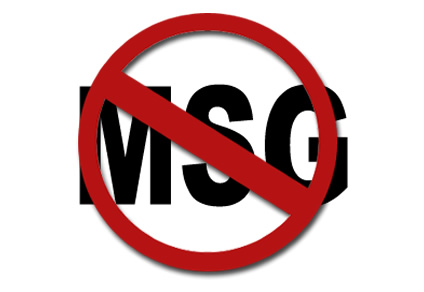|
April 10, 2012
from
PreventDisease Website
It's everywhere. It's in vaccines, medicine, foods, spices, household stain removers and elsewhere. It's extremely dangerous for aging brains and very young brains. Yet, we are exposed to dangerous "free glutamate" everywhere we go and it is slowly but surely destroying the minds of younger generations.
Glutamate, one of the most
abundant chemical messengers in the brain, plays a role in many
vital brain functions, such as learning and memory, but it can
inflict massive damage if it is accidentally spilled into brain
tissue in large amounts.
Glutamate flow in the brain is normally kept in check by a system of dam-like structures, which release a trickle of the substance only when and where it is needed.
But burst a dam - as happens in stroke, head trauma, and some other neurological disorders - and the treacherous messenger floods the brain. The surge of glutamate radiates out from the area of original damage, and kills neurons in nearby areas.
The expanded damage can leave in its
wake signs of impaired brain function, such as slurred speech and
shaky movement.
If this concept is borne out in clinical trials, it might be helpful in treating a variety of acute and chronic brain insults and diseases.
The breakdown of MSG typically consists of,
Any glutamate added to a processed food is not and can not be considered naturally occurring.
Natural glutamate in plants and animals is known as L-glutamic acid.
Our normal digestive process slowly
breaks down this natural or "bound" glutamic acid and it is then
delivered to glutamate receptors in our body and brain. Broken down
this way, it is harmless. In a factory, however, the bound glutamic
acid in certain foods (corn, molasses, wheat) is broken down or made
"free" by various processes (hydrolyzed, autolyzed, modified or
fermented with strong chemicals, bacteria, or enzymes) and refined
to a white crystal that resembles sugar.
This allows it to go into food unlabeled as MSG.
A label may say,
...but the product still contains varying amounts of "free" glutamic acid.
This makes it very difficult for consumers who
are trying to avoid it. It is also very dangerous for those who
suffer severe reactions to it. Many people who are very sensitive to
MSG experience respiratory, neurological, muscular, skin, urological
and even cardiac symptoms.
Because they can get us to eat almost anything. There is such an incredible amount of disinformation in the powers that regulate and control food, that they can get us to consume things with absolutely no nutritional value at all.
As long as manufacturing costs are minimized, and we keep buying their food, they'll keep making it regardless of the detriments to our health.
MSG has been proven to act as
an excitotoxin which stimulates the reward system of the brain, so we
think it tastes better (than it actually does) and consequently
consume more.
According to "Guyton and Hall Textbook
of Medical Physiology," since your body already produces glutamates,
excessive consumption of MSG can potentially disrupt the natural
order of the glutamate in your body.
Your body, however, contains a natural system built into your cellular structure that monitors glutamate levels. The vast majority of glutamate exists inside of your body's cells where it remains essentially inactive.
On the other hand, the extracellular
glutamate found in your body is the active type of glutamate because
it responds to the glutamate receptors located on the surface of
many of your cells.
A healthy neuron releases glutamate only when it needs to convey a message, then immediately sucks the messenger back inside. Glutamate concentration inside the cells is 10,000 times greater than outside them. If we follow the dam analogy, that would be equivalent to holding 10,000 cubic feet of glutamate behind the dam and letting only a trickle of one cubic foot flow freely outside.
A clever pumping mechanism makes sure this trickle never gets out of hand:
This protective pumping process works beautifully as long as glutamate levels stay within the normal range.
But the levels can
rise sharply if a damaged cell spills out its glutamate. In such a
case, the pumps on the cellular membranes can no longer cope with
the situation, and glutamate reveals its destructive powers. It
doesn’t kill the neuron directly. Rather, it overly excites the
cell, causing it to open its pores excessively and let in large
quantities of substances that are normally allowed to enter only in
limited amounts.
Cell swelling, however, is reversible; the cells will shrink back once glutamate is removed from brain fluids. More dangerous than sodium is calcium, which is harmless under normal conditions but not when it rushes inside through excessively opened pores.
An overload of calcium destroys the
neuron’s vital structures and eventually kills it.
In trauma, the damage is inflicted by a blow to the head. If the damaged area, called the core, is small and not located in a vital region of the brain, it might not cause major harm.
However, because the dead cells in the core spill out their glutamate, the core often becomes the center of a glutamate spill. While the center itself cannot be saved, the secondary damage triggered by glutamate release from damaged or dying brain cells could theoretically be prevented or at least limited, and perhaps even reversed.
Medical management can help to prevent
further damage, but effective neuroprotective drugs have, so far,
been hard to come by.
Other studies have shown that growth
hormone, thyroid hormones and many other endocrine functions can be
assaulted by
excitotoxins which may lead to growth retardation of
children before the age of puberty.
Yes, the research is clear that
excitotoxins can literally damage (and reduce in size) the future
development of your child's testes and ovaries.
|

